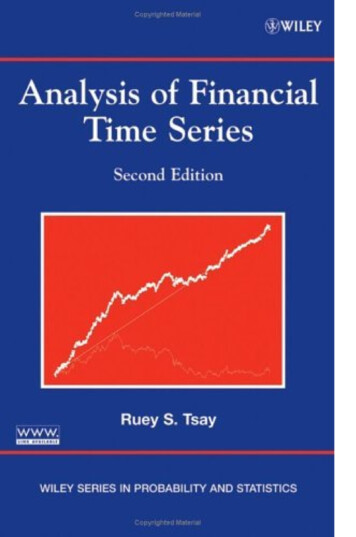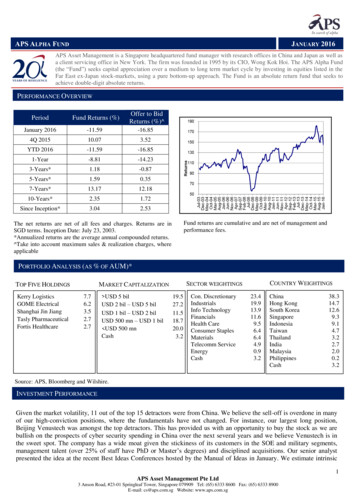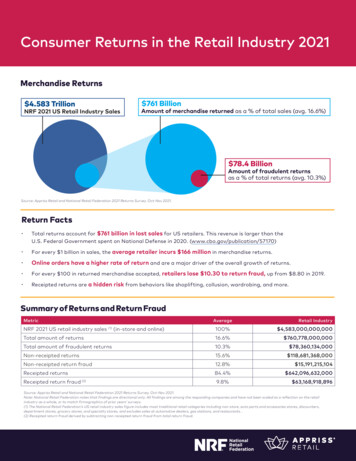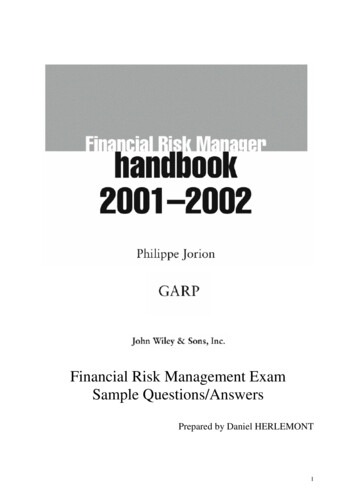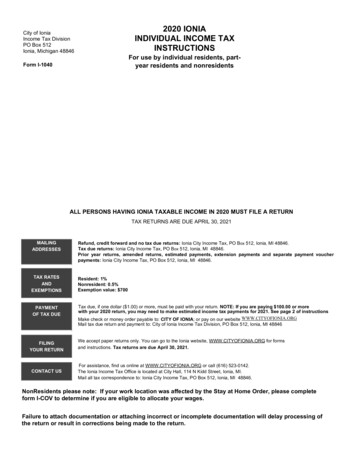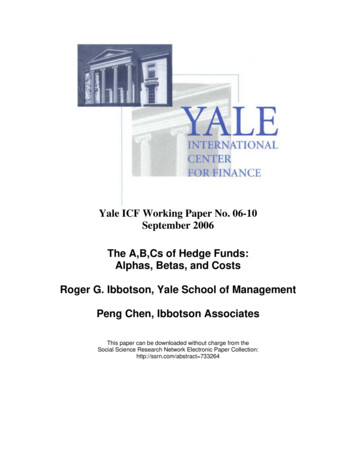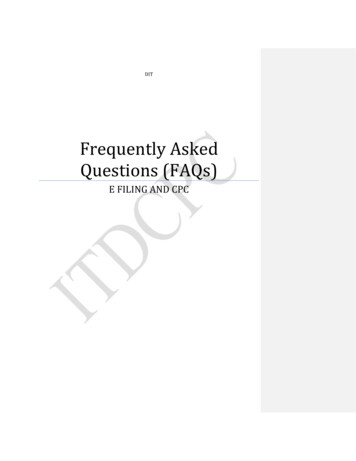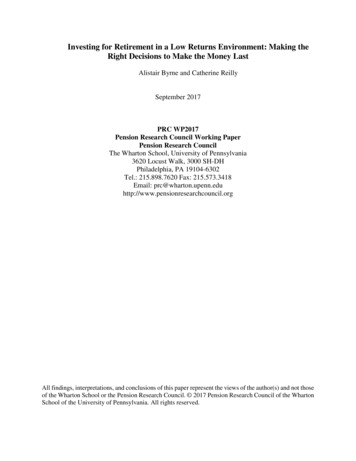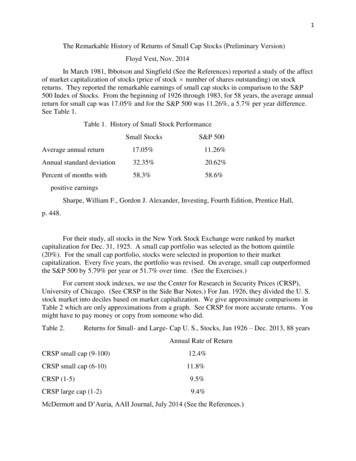
Transcription
1The Remarkable History of Returns of Small Cap Stocks (Preliminary Version)Floyd Vest, Nov. 2014In March 1981, Ibbotson and Singfield (See the References) reported a study of the affectof market capitalization of stocks (price of stock number of shares outstanding) on stockreturns. They reported the remarkable earnings of small cap stocks in comparison to the S&P500 Index of Stocks. From the beginning of 1926 through 1983, for 58 years, the average annualreturn for small cap was 17.05% and for the S&P 500 was 11.26%, a 5.7% per year difference.See Table 1.Table 1. History of Small Stock PerformanceSmall StocksS&P 500Average annual return17.05%11.26%Annual standard deviation32.35%20.62%Percent of months with58.3%58.6%positive earningsSharpe, William F., Gordon J. Alexander, Investing, Fourth Edition, Prentice Hall,p. 448.For their study, all stocks in the New York Stock Exchange were ranked by marketcapitalization for Dec. 31, 1925. A small cap portfolio was selected as the bottom quintile(20%). For the small cap portfolio, stocks were selected in proportion to their marketcapitalization. Every five years, the portfolio was revised. On average, small cap outperformedthe S&P 500 by 5.79% per year or 51.7% over time. (See the Exercises.)For current stock indexes, we use the Center for Research in Security Prices (CRSP),University of Chicago. (See CRSP in the Side Bar Notes.) For Jan. 1926, they divided the U. S.stock market into deciles based on market capitalization. We give approximate comparisons inTable 2 which are only approximations from a graph. See CRSP for more accurate returns. Youmight have to pay money or copy from someone who did.Table 2.Returns for Small- and Large- Cap U. S., Stocks, Jan 1926 – Dec. 2013, 88 yearsAnnual Rate of ReturnCRSP small cap (9-100)12.4%CRSP small cap (6-10)11.8%CRSP (1-5)9.5%CRSP large cap (1-2)9.4%McDermott and D’Auria, AAII Journal, July 2014 (See the References.)
2IFA.com gives for small cap stocks for the 86 years, 1928 to 2013, an average return of 11.20%.For the largest cap stocks, the top two deciles, CRSP (1-2), the average annual return wasapproximately 9.4%. For the smallest two deciles, CRSP small cap (9-10) it was 12.4%, and thesmallest five deciles CRSP small cap (6-10) it was 11.8%. What would be the growth of 1 foreach, over the 88 years? See the Exercises. You can see that there are different definitions forsmall cap stocks. The indexes are periodically revised.According to McDermott and D’Auria, one remarkable feature of CRSP (6-10) small capis that value small cap stocks significantly outperform other small cap stocks. From Jan. 1926 toDec. 2013, value small cap stocks earned approximately 17% annualized while CRSP (6-10)earned approximately 11.8%. Thus we have an interest in not only small cap stocks but alsosmall cap value stocks. (See Vanguard Small-Cap Value Index Fund (VISVX) in the Side BarNotes.)In order to rank small cap stocks by value, CRSP divided small cap stocks (CRSP 6-10)book .valueinto five asset classes based on Book to Market Ratio, BtM . BtM is the inversemarket.capof the common price-to-book ratio. Stocks with highest BtM were considered value stocks.Note for this, the value of the company was greater in proportion to the market cap. Forexample, if you look at the holdings of the Vanguard Small-Cap Value Index Fund whichfollows the CRSP U. S. Small Cap Value Index (9/30/2014), you will see the largest holding isSnap-on Inc. (SNA). From finance,yahoo.com, Key Statistics, we get1 .295 . The larger the BtM the greater the value3.39rating of the stock. You can look at the Constituent companies in the CRSP U. S. Small CapValue Index and see 806 stocks (Nov. 2014). This CRSP index holds stocks in proportion withmarket cap weightings meaning the portfolio holds each stock in the same proportion as itsmarket cap represented in the asset class (small value). Snap-on (SNA), with a market cap of 7.810B, the largest holding, is held in the proportion .005119 .5119% and HGG (the smallest,market cap 146.80M) is held in the proportion .0000196 .00196%. Notice that the market capof small value ranges from 7810M to 146.80M. With 806 stocks in small value, an “average1weight” would be .0012 .806Price/Book 3.39 and BtM for SNA A person might wonder if this outperformance by small value is still current. Toinvestigate, we compare Vanguard Small-Cap Value Index Fund with Vanguard 500 Index FundAdmiral Shares (9/30/14) in Table 3.Table 3 – Returns on small cap value compared to S&P 5001 year5 years10 yearsVanguard small value12.4715.508.83(Expense ratio .24%)Vanguard 50019.6815.678.10(Expense ratio .05%)Adding back in the above expense ratios.
3Vanguard small value12.7115.749.07Vanguard 50019.7315.728.15According to McDermot and D’Auria, Fama and French created the well-known smallcap-premium factor called SmB (Small minus Big) to measure the outperformance of U. S.small-cap stocks relative to U. S. large-cap stocks. The annualized return of SmB from Jan.1926 through Dec. 2013 is positive 2.22%. Thus we have evidence of the small-cap-premium.But, SmB is positive in only a little more than 50% of calendar years. So for a specific year, wehave a 50% guess. For SmB, the longest period of consecutive months for a negative SmB was220 months, 18.3 years. For CRSP (6-10) small cap, the longest draw down in consecutivemonths was 73 months and for CRSP (1-5) large cap, the longest was 34 months, about half.(See the Exercises for investments for a retiree or near retiree.) In the 32 year period (19822013), SmB’s annualized return was 0.96% and not statistically significant from zero. Whatabout small cap value stocks?There are several strategies which coordinate with value investing which enhance thereturns of a portfolio. Novy-Marx (2013) finds that gross profitability (revenue minus cost ofgoods sold, scaled by assets) along with traditional metrics does this. A simple value strategydoes not distinguish between companies that are profitable and those that are not. Includingvalue and profitability in selecting stocks is a better value strategy. This applies particularly tosmall cap stocks. (Search the internet for Robert Novy-Marx, “The Quality Dimension of ValueInvesting,” University of Illinois at Chicago.) There are funds which incorporate this and otherstrategies, such as momentum, to generate larger abnormal returns. Momentum involves stockswhich performed well recently. Historical studies have shown that such stocks are likely toperform well for a period of time.An index such as the S&P 500 has rules for selection of stocks so that a stock can beadded by purchase, or a stock can be removed by sale, all in one day.The Russell 2000 isprobably the most widely followed U.S. small cap index. Historically, studies indicate the indexlost from 0.38% to 1.84% annualized in market these impact costs. Traders make money offsuch an event. One way to avoid this market impact cost is to own the Vanguard Total StockMarket Fund. Study this fund to see how it manages about 5000 stocks. What kind of newofferings- stocks does it buy, and what kind of stocks does it sell? (The Morningstar Guide toETF Investing, 2014). For the S&P 500, a stock worth 1% of the index getting removed means 16B worth of the stock is sold in one day.Side Bar Notes:Small cap stocks. Investopedia.com says that small cap stocks vary in marketcapitalization from 300M to 2B. They constitute 17.6% of company stocks. Definitions ofsmall cap stocks have changed over time. What was consider large cap in 1980 is small captoday.CRSP, The Center for Research in Security Prices, Chicago Booth Business School,University of Chicago. Go to crsp.com and click your way around and see what you can learn.You can read about the CRSP U. S. Small Cap Value Index. They feature the work of highly
4regarded investment researchers Fama and French. CRSP maintains the most complete data basefor stocks, bonds, and mutual funds.Masters degrees in financial mathematics. Major universities offer masters degrees withemphasis in financial mathematics. Some degrees are referred to as Masters in FinancialEngineering, but at Stanford a Master of Science in Financial Mathematics (MSFM) is offered,Chicago offers a MSFM, Boston a MSFM, Minnesota a MSFM, and Rutgers a Master of Sciencein Mathematical Finance (MSMF). Other titles are MSFE, MMF. See the internet forprograms and rankings, and job offerings.Beta and Sharpe ratio for small caps. McDermott and D’Auria report beta for CRSP6-10 (small caps) of 1.31 and a Sharpe ratio of 0.413. For the market (CRSP 1-10), they report aSharpe ratio of 0.419. Interpret. See the articles in the references.Rebalancing a portfolio of 60% stocks and 40% bonds. If the market rises, the equityexposure will exceed the 60%. This is an opportunity to sell high. If the market drops, theexposure will be less than 60%. This is an opportunity to buy low. The rebalanced portfolio willproduce greater returns than its constituents. If handled well, volatility can outperform otherreturns.Ifa.com a good read. Eugene Fama and Kenneth French developed for stock investmentasset allocation and portfolio analysis a Three factor model consisting of the Value factorpremium, the Small factor premium, and the Market factor premium (ifa.com). You can learn alot more by reading ifa.com. The Value factor premium is Value minus growth companies, theSmall factor premium is US small minus US large, and the Market factor premium is Total USmarket minus T-Bills. Ifa.com is a fee only advisor, and supplies index funds based on CRSPindexs which have 86 years of historical studies.Modern portfolio theory. Harry Markowitz, Ph. D., in his 1952 Nobel Prize-winningarticle, “Portfolio Selection” asserted that the best portfolios include non-correlated stocks thusreducing risk for a good return (ifa.com). (See articles in this course.)Index funds are tax efficient since they do less trading. Tax managed index funds offsetrealized gains with realized losses, deferring net capital gains and minimizing dividend income.The benefit is that unrealized capital gains remain a growing part of the net asset value. Taxeson gains are not paid until withdrawals, and gains become realized (ifa.com).Bogle on index funds. After a 15 year study, Bogle says that investors keep 47% of theaccumulated returns of an average actively managed mutual fund, investors keep 87% in a lowcost market index fund. The actively managed return to the investor is depleted by expense ratio,commission, transaction costs, taxes, cash drag (ifa.com). They report that 10,000 invested inan actively managed fund grew to 49,000 versus 90,000 in an index fund. Explain thesenumbers.Survivors in the S&P 500. Foster and Kaplan, in a study of the S&P 500, found that forthe 500 companies in 1957, the original S&P 500, only 74 remained in in 1997. Only 12 beatthe index from 1957 to 1998 (ifa.com).The first index fund available to individual investors. On Dec. 31, 1975, John Boglecreated what is now known as the Vanguard 500 Index Fund. The fund was met with criticism
5and called “Bogle’s folly.” Today, it one of the largest mutual funds. Since then Bogle hasbecome one of the most respected in finance (ifa.com).Longevity. For the average population, chances for one or both of a couple to lie to age95 is 19%, for the upper middle class it is 43%, and it is calculated that by 2029, for the uppermiddle class it is 50%. To what age should you plan for retirement and when should you retire?See the articles on retirement calculations in this course and do you own calculations. Howmuch is required to fund retirement? Money reports that for the highest income quartile, about12% will not have enough retirement resources to live to age 100. Of the third quartile, it is30%. Of the second quartile, it is 48%. Do you want to be an average retiree or an averagestudent? (Money, Nov. 2014, page 55)How much is needed to draw 40,000 the first year in retirement? One million dollars isrequired for a 25 year retirement, 1.18M for 30 years, 1.35M for 35 years. The safe amount towithdraw the first year from 1M is 40,000 for a 25 year retirement, 34,000 for a 30 yearretirement, and 30,000 for a 35 year retirement. Note: Assumes a 40% bonds, 60% stocksportfolio, 80% probability of success, David Blanchett, Morningstar. (Money, Nov. 2014, page58) You can have a lot of fun working with these numbers. What do they assume is withdrawnthe second year?Part-time work or full retirement. Assume a 100,000 salary for full-time work, 50,000for part-time work, 500,000 in savings at age 60, a 40% stock/ 60% bond investment, averageearnings of 6% per year, 10% contributed each year to a 401(k) when working full-time, delaySocial Security until full retirement. How much yearly income can you expect? Full retirementat age 62, 50,800; work part-time 62 to 66, 66,700; full retirement at Age 66, 69,500; workpart-time age 62 to 70, 71,600; work par-time 66 to 70, 87,900; full retirement at age 70, 93,400. (Money, Nov. 2014, page 62, Source T. Rowe Price.) What did they assume aboutinflation of salary and withdrawals, longevity, and social security, etc? Have fun with thesenumbers. Did you know that if you used a real rate of return, this takes care of increasing salaryand increasing withdrawals? See an article in this course.Taking the pension or investing the cash value? Assuming a 2500 a month pension witha cash value of 440,000 which could be invested in a 50/50 stock/bond portfolio, 9% annualreturn on stocks, 3% on bonds. What is the chance that the investment lasting 30 years if yourwithdrawals equal the pension? Answer: 40%. (Source: Pension Benefits, David Blanchett,Money, Nov. 2014, p. 82) Does the pension have a COLA?Variable annuity versus mutual fund. Assume 100,000 is invested in a 50/50stock/bond mutual fund, or a variable annuity, with 9% return for stocks and 3% for bonds,mutual fund expense ratio 0.7%, variable annuity expense ratio 1.3%, and after two years startwithdrawing 5000 per year for 30 years. The mutual fund grows to about 160,000, thevariable annuity to about 110,000, and if the variable annuity is replace by another at 2 years,the variable annuity declines to about 83,000. Explain. (Source: David Blanchett,Morningstar, Money, Nov. 2014, page 83)Titles that suggest financial expertise. The Consumer Financial Protection Bureau hascounted more than 50 titles that suggest financial expertise, with some requiring little more thana check and a multiple choice exam. (Money, Nov. 2014, page 85)
6Did they go to the free financial dinner? When FINRA surveyed investors age 40 andover, 32% reported having gone to as lunch that turned out to be a sales pitch. (Money, Nov.2014, page 85)Small stocks slip into a correction. In the four weeks ending Oct. 1, 2014, the Russell2000 small cap index dropped more than 10%. As of Oct. 1, for one month, the S&P was down2.7%. (Money, Nov. 2014, page 102)What is most important for students, football or financial education? Rampant academicfraud occurs in the nation’s colleges. At the University of North Carolina, the state’s flagshipuniversity, over two decades, more than 3100 students received credit for taking nonexistentphantom classes, nearly 50 percent were university athletes. (Denton Record Chronicle, Nov. 8,2014) How many colleges provide a general financial education?Historical data and back testing. Search the internet for back testing a theory aboutstocks. Read about problems with back testing. See “Fool’s Gold: Why Most Back-TestedFund Performance Histories are Bunk,” Morningstar. See Charles D. Ellis, “The Rise and Fall ofPerformance Investing,” Financial Analysts Journal, July/August, 2014, pages 14 to 23. SeeWikipedia.org, backtesting (one word), and check the references.Back testing for better stock returns has resulted in over 200 discoveries in the last 15years. They identify factors such as company size that are associated with out performance.Many mutual funds are sold based on claims of such factors and out performance. “But a studyby economists Campbell Harvey, Yan Liu, and Heqing Zhu argue that many of these discoveriesare probably illusory. The sheer number of findings, the study argues, suggests researchers aresimply picking up a lot of random noise,” (Money, Dec. 2014, page 81) Discuss: What are theysaying?ChicagoBoth.edu/impact. In her hedge fund world, Roxanne Martino and the AuroraFund have consistently outperformed benchmarks. She used the Chicago approach (CRSP).(Bloomberg Business Week, Nov. 10, 2014)Exercises: Show your work. Label answers, numbers, and variables. Discuss in completesentences. Label graphs.#1.On fool.com, Motley Fool said that Fama and French at CRSP developed methods fordetermining and updating different portfolios and that for the 78 years from 1927 to 2005, LargeCap Value grew 100 to 898,967; Small Cap Value grew 100 to 7,367,903; Large Growthgrew 100 to 130,165; and Small Growth grew 100 to 103,165. (a) How does the endresult of Small Cap Value compare to that of Small Cap Growth? (b) Calculate the averagecompound growth rate for each portfolio. (c) On a grapher, graph and report a growth curve forSmall Cap Value for the 78 years from 0, and build a table for the results for 10 year intervals.Graph by hand with a linear vertical axis in intervals of 1M, and a horizontal axis in intervals of10 years. Discuss the graph. What do you know about the increase of funds at various 10 yearintervals and the rate of increase of the slope? Interpret this in terms of practical investing.What do you know about the slope of the curve at each point and the rate of increase of thedyslope? See thefunction on page 3-28 of the TI83 manual.dx
7#2.For Table 1, calculate the compounded sum of 1 invested for 58 years for Small capstocks and the S&P 500. The final amount for Small cap is what multiple of that for the S&P500?#3.For a normal distribution and Table 1, for Small Stocks and the S&P 500, what is and the percentage of returns from down to , what is 2 and the percentage ofreturns down to 2 ? What is a 3 event for each and what is the probability? Is thereevidence that such a distribution is not normal but skewed to the left? See articles in this course.#4.Calculate BtM for SNA by a method different from the one used in the above discussionof BtM of SNA.#5.The comparison between small value stocks and the S&P 500 in Table 3 does not displaya significant advantage of small value stocks, but the comparison of small value cap at 17% andCRSP small cap (6-10) at 11.8% is impressive. (a) Trace the logic for the comparison of thethree types of stocks in these figures and Table 1. (b) Try to find some better historicalevidence of the outperformance of small value stocks over the S&P 500.#6.For a retiree or near retiree who feels they can’t tolerate an extensive draw down, what doyou think about investments in small cap stocks? Give calculations and historical evidence.#7.McDermott and D’Auria report that for SmB, a mean annualized return of 0 .96% for 32years is not statistically significant from zero. If 100 years is required for 95% confidence thatthe long term mean is greater than zero, estimate the standard deviation of SmB.#8.From #7, if 100 years is required to indicate that a mean for SmB of 0.96% is statisticallysignificant at the 95% confidence level from the long term mean of 2.22% , estimate the standarddeviation of SmB.#9.What would be a simple way for CRSP to separate out growth stocks?#10. Study finance.yahoo.com and other sources for Snap-on Inc. (SNA), which is a smallvalue stock (See CRSP.) and check to see if it is a momentum stock, and a profitable company.Give your sources, discuss.#11. Felix Salmon said that in Jan. 2001, he purchased a TiBook for 2600. He says that if hehad bought 2600 of Apple stock instead, it would be worth 200,000 today. (Money, Nov.2014, page 108) (a) What was the rate of return on the Apple stock price? (b) What aboutdividends and splits? (c) Look up Apple stock on finance.yahoo.com and learn about Applestock. Report.#12. A publication claimed that since 1991, by Fall 2014, a Vanguard fund was up 1,324%.What is the compounded annual rate of return? Figure it with two interpretations. What is theannual arithmetic rate of return.
8References:Sharpe, William F., Gordon J. Alexander, Investments, Fourth Edition, Prentice-Hall.McDermott, John B., Dana M. A’Auria, “How Much Small Cap Should Be in Your Portfolio?”AAII Journal, July, 2014.In this course:“Annual Total Return Table for the S&P 500 Index of Stocks,” July 2013.“Standard Deviation as a Measure of Risk for a Mutual Fund,” Summer 2011.“Measures of Risk and Performance for Mutual Funds: Beta, Alpha, and Sharpe Ratio,” Sept.2011.“Covariance and Correlation in Finance,” June 2012.“Evaluation of Investments: irr, mirr, AM, TR, and HM,” Oct. 2011.“The S&P 500 Index of Stocks and Three Sigma Events,” Aug. 2014.For a free course in financial mathematics, with emphasis on personal finance, for upper highschool and undergraduate college, see COMAP.com. Register and they will e-mail you apassword. Simply click on an article in the annotated bibliography, download it, and teach it.Unit 1: The Basics of Mathematics of Finance, Unit 2: Managing Your Money, Unit 3: LongTerm Financial Planning, Unit 4: Investing in Bonds and Stocks, Unit 5: Investing in RealEstate, Unit 6: Solving Financial Formulas for Interest Rate, For about thirteen more advanceor technical articles, see the UMAP Journal at COMAP. The last section is Additional Articleson Financial Mathematics or Related to Personal Finance. In all, there are about eighty articles.
Chicago offers a MSFM, Boston a MSFM, Minnesota a MSFM, and Rutgers a Master of Science in Mathematical Finance (MSMF). Other titles are MSFE, MMF. See the internet for programs and rankings, and job offerings. Beta and Sharpe ratio for small caps. McDermott and D'Auria report beta for CRSP 6-10 (small caps) of 1.31 and a Sharpe ratio of 0.413.


